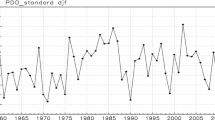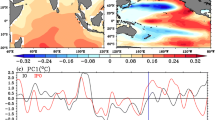Abstract
Multi-year Simple Ocean Data Assimilation (SODA) and National Centers for Environmental Prediction (NCEP) datasets were used to investigate the leading patterns of subsurface ocean temperature anomalies (SOTA) and the corresponding atmospheric circulation structure in the Pacific Ocean (20°S–60°N). In this paper, the evolution of North Pacific SOTA associated with El Niño-southern oscillation (ENSO), and their relationship with the overlying zonal/meridional atmospheric circulations were elucidated. The results indicate that: (1) there are two dominant modes for the interannual variability of the North Pacific SOTA. The primary mode is the dipole pattern of the central and western North Pacific SOTA associated with the leading mode of ENSO, and the second mode is the zonal pattern related to the second mode of ENSO. These two modes consist of the temporal-spatial variation of the SOTA in the North Pacific. (2) During the developing phase of the El Niño event, positive (negative) SOTA appears in the western (central) portion of the North Pacific Ocean. During the mature and decaying phase of the El Niño event, the western positive center and the central negative center continue to be maintained and enhanced. Meanwhile, the position of the western positive center slightly changes, and the central negative center moves eastward slowly. After the El Niño event vanishes, the positive SOTA disappears, and the central negative SOTA becomes weak and remains in the northeastern Pacific Ocean. The results for La Niña are generally the opposite. (3) During the El Niño/La Niña cycle, formation and evolution of the SOTA, with opposite signs in central and western North Pacific Ocean, resulted from vertical movement of the two northern branches of the Hadley Cell with opposite direction, as well as the positive feedback of the air-sea interaction induced by dynamic processes in the mid-latitudes. The former gives rise to the initial SOTA, and the latter intensifies SOTA. Under the forcing of these two processes, SOTA evolution is formed and sustained during the El Niño/La Niña events. Also discussed herein as background for the ENSO cycle are the possible connections among the West Pacific subtropical high, the strength of the Kuroshio near the East China Sea, the Kuroshio meanders south of Japan, the Aleutian Low, and cold advection in the central North Pacific Ocean.
Similar content being viewed by others
References
Alexander M A, Blade I, Newman M et al. 2002. The atmospheric bridge: the influence of ENSO teleconnections on air-sea interaction over the global oceans. J. Climate, 15: 2 205–2 231.
Carton J A, Chepurin G, Cao X et al. 2000a. A simple ocean data assimilation analysis of the global upper ocean 1950–1995, Part 1: methodology. J. Phys. Oceanogr., 30:294–309.
Carton J A, Chepurin G, Cao X. 2000b. A Simple Ocean Data Assimilation analysis of the global upper ocean 1950–1995, Part 2: results. J. Phys. Oceanogr., 30: 311–326.
Chao J P, Yuan S Y, Chao Q C et al. 2003. The origin of warm water in “warm pool” subsurface of the western tropical Pacific-the analysis of the 1997–1998 El Niño. Chin. J. Atmos. Sci., 27(2): 145–151.
Frankignoul C. 1985. Sea surface temperature anomalies, planetary wave, and air-sea feedback in the middle latitudes. Rev. Geophys., 23: 357–390.
Gong Y F, He J H, Duan Y Y, et al. 2006. Numerical experiment on the influences of minus-SSTA over mid-latitude Northern Pacific on the subtropical anticyclone. J. Trop. Meteor., 22(4): 386–392. (in Chinese with English abstract)
Huang R H, Sun F Y. 1994. Impacts of the thermal state and the convective activities in the tropical western Pacific warm pool on the summer climate anomalies in East Asia. Scientia Atmospherica Sinica, 18(2): 141–151. (in Chinese with English abstract)
Kalnay E, Kanamitsu M, Kistler R et al. 1996. The NCEP/NCAR 40-year reanalysis project. Bull. Amer. Meteor. Soc., 77: 437–470.
Liu Q, Wen N, Liu Z. 2006. An observational study of the impact of the North Pacific SST on the atmosphere. Geophys. Res. Lett., 33: L18 611.
Miller A J, White W B, Cayan D R. 1997. North Pacific thermocline variations on ENSO timescales. J. Phys. Oceanogr., 27: 2 023–2 038.
Peng J Y, Sun Z B. 2000. Influence of Spring Equatorial Eastern Pacific SSTA on Western Pacific Subtropical High. Journal of Nanjing Institute of Meteorology, 23: 191–195. (in Chinese with English abstract)
Wang B, Wu R G, Fu X H. 2000. Pacific-east Asian teleconnection: how does ENSO affect Asian climate. J. Climate, 13: 1 517–1 536.
Wang C. 2002. Atmospheric circulation cells associated with the El Niño-Southern Oscillation. J. Climate, 15: 399–419.
White W B. 1995. Design of a global observing system for gyre-scale upper ocean temperature variability. Progress in Oceanography, 36: 169–217.
Xie S P, Hu K, Hafner J et al. 2009. Indian Ocean capacitor effect on Indo-western Pacific climate during the summer following El Niño. J. Climate, 22: 730–747.
Ying M, Sun S Q. 2000. A Study on the Response of Subtropical High over the Western Pacific on the SST anomaly. Acta. Oceanol. Sin., 24: 193–206. (in Chinese with English abstract)
Zhang Q Y, Tao S Y. 1998. Tropical and subtropical monsoon over East Asia and its influence on the rainfall over eastern China in summer. Quarterly Journal of Applied Meteorology, 9: 16–23.
Zhao Y P, Chen Y L, Wang F et al. 2007. Mixed-layer water oscillations in tropical Pacific for ENSO cycle. Sci. China Ser.: D-Earth Sci., 50(12): 1 892–1 908.
Author information
Authors and Affiliations
Corresponding author
Additional information
Supported by the Knowledge Innovation Program of Chinese Academy of Sciences (No. KZCX2-YW-Q11-02) and the National Basic Research Program of China (973 Program) (Nos. 2007CB411802 and 2006CB403601)
Rights and permissions
About this article
Cite this article
Chen, Y., Zhao, Y., Wang, F. et al. Subsurface temperature anomalies in the North Pacific Ocean associated with the ENSO cycle. Chin. J. Ocean. Limnol. 28, 1304–1315 (2010). https://doi.org/10.1007/s00343-010-9078-2
Received:
Revised:
Published:
Issue Date:
DOI: https://doi.org/10.1007/s00343-010-9078-2




